Lessons in physics and chemistry from your favorite winter drinks
When it’s cold outside, there’s nothing cozier than a warm mug of cocoa, some spiced cider, or a steaming cup of your favorite tea. But here at NOAA, we always have Earth science on the brain. As we settled down to relax with our warm winter drinks, our inner oceanographers couldn’t help but think, hey, that looks familiar!
The ocean is vast compared to a single cup of coffee, but you might be surprised to learn how much they are alike! We have some tasty try-this-at-home activities that show the physics and chemistry at work in both. What do sea foam and your morning chai have in common? (Hint: a latte!) Which ocean sampling tools bear a striking resemblance to kitchen gadgets? Can you generate upwelling in your hot cocoa? We’ll cover all of this and more. So pour yourself a cup, and start learning!
Jump to activity
- Sea for yourself: How does foam form?
- How turbid do you take your tea?
- "Plankton" in your cider
- Make your own cocoa-cline (part 1)
- What's up(welling) in your drink? (part 2)
Sea for yourself: How does foam form?
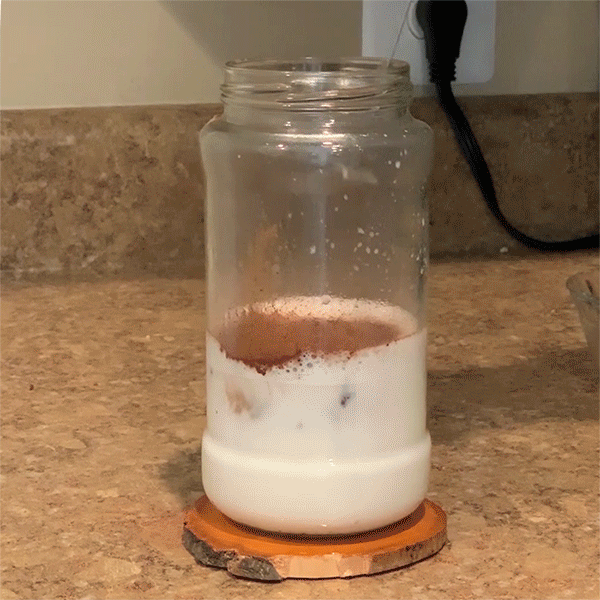
If you’ve ever walked along the beach on a windy day, you’ve probably felt foam squishing between your toes along with the sand. That sea foam actually forms in a very similar way to the milk foam in your favorite winter latte!
In both cases, proteins, air, and water are the three main ingredients that cause foam to form. Most people know that milk contains proteins, but it may come as a surprise that seawater does, too. In seawater, proteins often come from dead and decaying sea life, like algae or zooplankton. As they break down, they release molecules, including proteins, into the water. Whether in milk or in seawater, these proteins can trap air. So, when the waves and wind push air into the ocean, or the barista uses a steaming wand to froth the milk for your latte, foam forms. Read more about how proteins, and other types of molecules, lead to sea foam.
Try this at home:
- Warm up your milk, but not too much! You should be able to hold your hand to the mug comfortably. Heating up the milk causes proteins in the milk to start to break down, which leads to better form formation. However, bringing the milk to a very high temperature can break down the proteins too much.
- You can use a milk steamer or milk frother to make foam, but you can also use a blender or handheld mixer. Or simply get a jar with a lid and shake up the milk by hand.
- Watch the sea foam demonstration video.
How turbid do you take your tea?
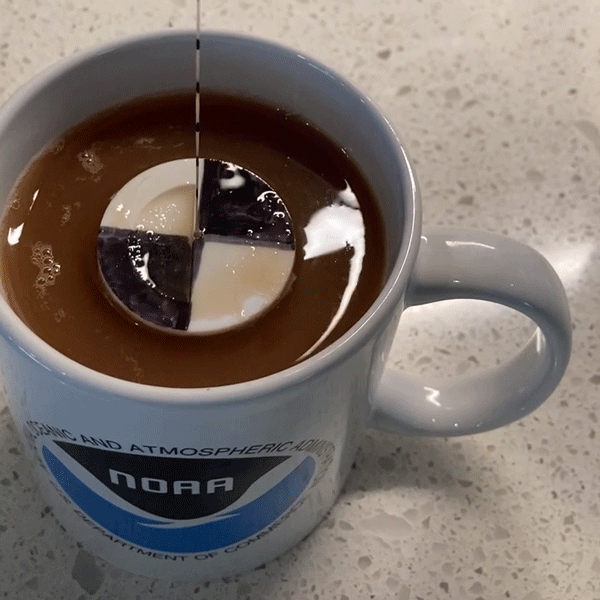
Whether you like your tea or coffee black or with a lump of sugar and a splash of milk, you’ve probably noticed that the more milk or cream you add, the cloudier the liquid becomes. In the ocean, too, the amount of material suspended in water determines how clear it is. Light is important because it’s required for photosynthesis. The clarity or turbidity of the water can also give experts a quick snapshot of water quality, whether it’s crystal clear, murky with algae, or cloudy from river runoff. Oceanographers have a standardized and simple way to measure this: the secchi (pronounced “sek-key”) disk! Named for Pietro Angelo Secchi offsite link who described the method in 1865, this disk is lowered on a rope or a stick to the depth just before it vanishes from sight. Because this information is so easy to collect, researchers can use it to monitor trends in water quality over time. Secchi disks are also used to monitor freshwater; watch secchi disk sampling in action in the Great Lakes.
Try this at home:
- We had a bit of fun making a mini secchi disk for our teacup, but it was a little more complicated than our other demonstrations in this series. It involved drilling a hole in a small disk, using metal washers to help the disk sink, and holding things together with heavy-duty duct tape. But if you'd like to use your mini secchi disk for, shall we say, long-term coffee monitoring, you should look into food-safe and heat-safe adhesives.
- You can simply note the depth at which a spoon or tea bag vanishes in your tea or coffee. And let us know: what’s the “secc-tea” depth of your perfect cup?
- Watch the secchi disk demonstration video.
“Plankton” in your cider
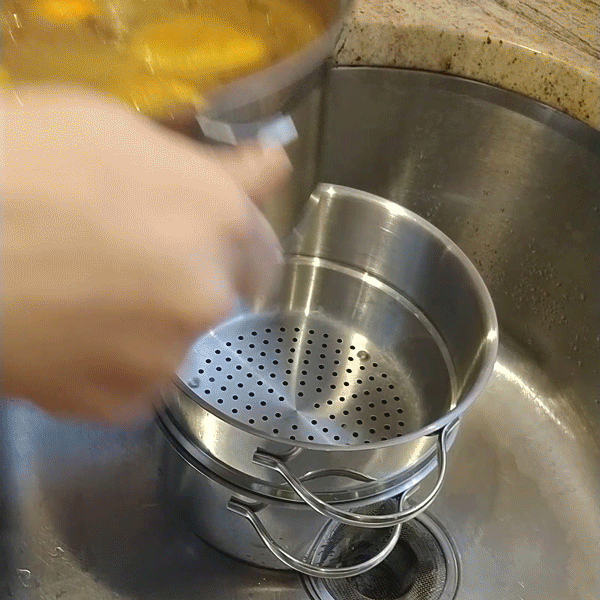
Did you know that straining out spices from hot mulled cider is similar to what plankton researchers do? You might first pour your cider through a colander with wider holes to strain out bigger pieces of clove or allspice, then switch to a mesh sieve to remove smaller bits of cinnamon powder or orange pulp. If you dumped it all through the mesh sieve at first, it might get clogged with all the bigger pieces.
When scientists catch plankton from the ocean, they use a net with very specific sized holes in the mesh. “Plankton” is a broad term for any living thing that drifts with ocean currents and can’t swim against them. These organisms that “go with the flow” can be animals, algae, bacteria, or fungi. They come in many different sizes, from microscopic diatoms to larger animals like jellyfish. Plankton nets have holes that can be as small as 1/1000 of a millimeter (you can’t see these without a microscope) or as large as 5 millimeters (about the size of a pencil eraser). Smaller holes will catch smaller plankton. NOAA often uses side-by-side plankton nets, called bongo nets offsite link, with different mesh sizes. Scientists can use precise nets and strainers to find exactly the size of plankton they are looking for, which can give us insight to the health of the plankton community — an important thing to know, since plankton form the base of the marine food web.
Try this at home:
- Be sure to include different sized “plankton” in your cider: ground spices, whole spices, orange slices, and more. Yum!
- Watch the plankton demonstration video.
Make your own cocoa-cline (part 1)
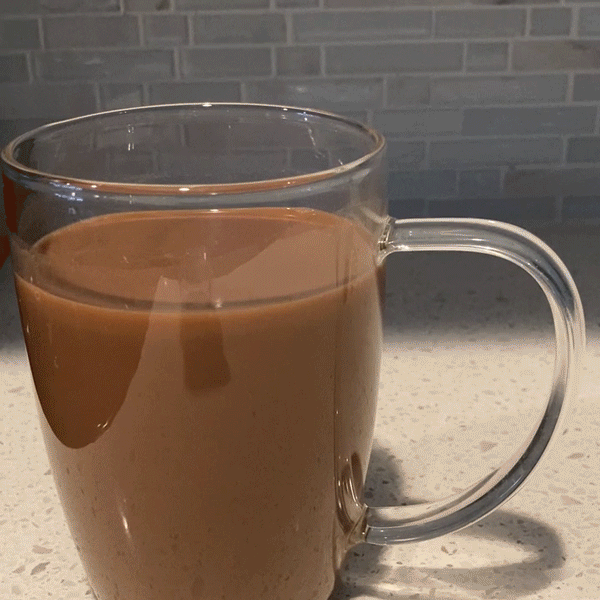
Looking to impress with a fancy layered mocha or hot chocolate like this cocoa topped with espresso and warm milk? We can create layered treats by playing around with the density of liquids.
First, a quick primer on density: Density measures how massive something is relative to its volume. In the ocean, the two biggest factors that affect density are temperature and salinity. Cold water is denser than warm water, and saltwater is denser than freshwater. In our hot cocoa, things work pretty much the same way, except that instead of salinity, we’re dealing with different amounts of sugar, protein, and fat.
When we pour hot milk on top of cooler cocoa, the milk floats on top because it’s less dense. The hot espresso is denser than the milk but less dense than the cocoa; it settles in the middle. Finally, we can also see that these layers with different densities don’t readily mix. (But see part 2 of this activity!)
The ocean has different layers, too! There’s often a surface layer in which the water has been heated by the sun and mixed by wind and waves. That layer sits on top of colder, saltier, denser water. You may have felt this when swimming in a deep lake or the ocean — the water around your upper body might be warm while the water at your toes is cold. The area where the temperature changes from warmer to cooler is called the “thermocline,” and it’s a very important feature in oceanography. The thermocline can be close to the surface or over a thousand meters deep. The depth of the thermocline can help scientists figure out when we’ll experience El Niño and La Niña conditions and estimate how much warm water is available to fuel tropical storms and hurricanes. And that is just the beginning! Layering of water affects life both in the ocean and on land in many ways, from determining how whale songs or sonar signals travel through the water, to how heat and water move around the globe.
Try this at home:
- Be sure your ingredients are different temperatures, and please be careful when working with hot liquids! If you don’t have a thermometer, you can heat the cocoa until it is warm but not hot — you should be able to rest your hands comfortably around the mug at this stage. The warm milk and espresso should be heated until they are just starting to steam but not boiling. You will need to handle them carefully, using a towel or mitt to protect your hands.
- If you don’t have a glass mug, you can use any heat-safe glass container such as a canning jar (without the lid) or a liquid measuring cup.
- We used powdered espresso for the coffee layer. It helps to make it very strong — the more coffee is dissolved in the water, the denser it becomes!
- Pouring gently is key. If you dump one layer on top of another, they’ll mix together through turbulence. Pour from a cup with a spout and use a spoon to slow the flow.
- Play around with it! Stacking hot on top of cold and less sweet on top of sweeter will result in more stable layers. However, you can also try pouring in colder, sweeter liquid to see what happens.
- Watch the layered hot chocolate demonstration video.
What’s up(welling) in your drink? (part 2)
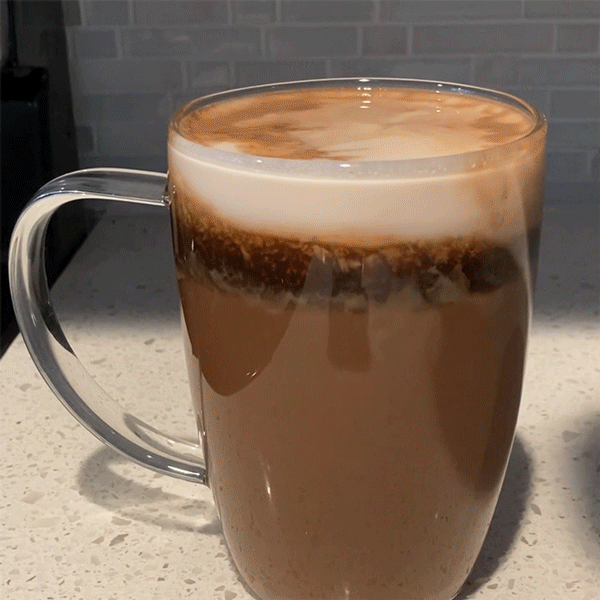
It’s a natural reaction: before you take a sip of a warm drink, you gently blow across the surface. But have you noticed that, in addition to cooling your drink down, this also mixes the liquid?
First, blowing across the surface of your cocoa forms small ripples. Believe it or not, this is the same process that generates wind-driven waves in the ocean! It also creates a small surface current, moving the top layer of water away in the direction the wind is blowing. Water from below is drawn up to replace it, bringing denser, colder, saltier water that is also packed with nutrients to the surface. Oceanographers call this phenomenon “upwelling.” It can take place in the open ocean or along the coast, and it’s an important process in “fertilizing” the surface water, providing more nutrients that help algae grow. Learn more about ocean currents.
Try this at home:
- You don’t need a dramatically layered drink to see this effect! Keep an eye out for it in spiced cider, miso soup, or to speed up mixing when you add cream to coffee. Let us know where you see upwelling.
- Because we’re demonstrating this effect in a closed container rather than the open ocean, we’re getting some edge effects. This means it’s functioning more like a lake! You can learn more about upwelling in the Great Lakes.
- Watch the upwelling demonstration video.
If you take on any of these demonstrations at home, we’d love to hear how it goes — but again, please be careful when working with hot liquids! Have you spotted other Earth science phenomena where you weren’t expecting them? Let us know by emailing us at education@noaa.gov or tagging us on social media. We're @NOAAeducation on Facebook, Twitter, and Instagram.
UPDATE - 2/4/2020: After seeing comments on social media, we added a bit more information about how we made a mini secchi disk.

